Isla Plaza Sur to Isla Santa Fé. Sunday, 17 April, 2011
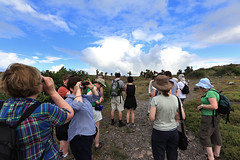 The boat sailed in the night, picking up its anchor about 02:00. This was a noisy affair, and then the engines added to it, and we slipped out of the relatively gentle waters of the harbour into the open sea, where the waves rocked the boat more vigorously. Not that I was sleeping anyway – the rocking of the boat made it difficult to even stay in one position on the bunk without rolling slightly. I dozed fitfully until morning, when we arrived at the sheltered bay between the small islands of North Plaza and South Plaza, off the eastern coast of the much bigger Santa Cruz.
The boat sailed in the night, picking up its anchor about 02:00. This was a noisy affair, and then the engines added to it, and we slipped out of the relatively gentle waters of the harbour into the open sea, where the waves rocked the boat more vigorously. Not that I was sleeping anyway – the rocking of the boat made it difficult to even stay in one position on the bunk without rolling slightly. I dozed fitfully until morning, when we arrived at the sheltered bay between the small islands of North Plaza and South Plaza, off the eastern coast of the much bigger Santa Cruz.
The dawn looked gorgeous in the islands and this washed away the drowsiness of the night. A few other large boats were moored in the same bay, and we could see groups of people making excursions on to the land via dinghies. Our turn would come later, after breakfast. There was a selection of cereal, fruit, bread, and pancakes, plus French toast, which Anne declared to be her absolute favourite breakfast, thanking Francesco for it. It was made on a slightly sweet brioche-like bread, and was nice.
 Following this, we assembled at the aft deck for our first land excursion on an uninhabited island. South Plaza is a small island of volcanic rock, only a few hundred metres long east to west and a few tens of metres wide north to south. The island rises on a gentle slope out of the bay between itself and the parallel North Plaza until it reaches cliffs maybe 10 metres high on the southern side that drop into the sea below. The dinghies took us to a concrete landing platform, where we had our first encounter with real Galapagos wildlife. This consisted mostly of sea lions, sprawled out on the rocks everywhere. They were totally unconcerned at human presence, ignoring us as we walked around and in some cases over them as they lay across the path. Some of them were moving around, splashing in or out of the water along the shore, or clambering around on the rock, but most seemed to be asleep. We saw some pups suckling milk from their mothers. They were of moderate size, friendly, and unimposing looking, which was good, because I know how large and dangerous some species of pinnipeds can be. At no stage did any of them make so much as a hostile gaze at us.
Following this, we assembled at the aft deck for our first land excursion on an uninhabited island. South Plaza is a small island of volcanic rock, only a few hundred metres long east to west and a few tens of metres wide north to south. The island rises on a gentle slope out of the bay between itself and the parallel North Plaza until it reaches cliffs maybe 10 metres high on the southern side that drop into the sea below. The dinghies took us to a concrete landing platform, where we had our first encounter with real Galapagos wildlife. This consisted mostly of sea lions, sprawled out on the rocks everywhere. They were totally unconcerned at human presence, ignoring us as we walked around and in some cases over them as they lay across the path. Some of them were moving around, splashing in or out of the water along the shore, or clambering around on the rock, but most seemed to be asleep. We saw some pups suckling milk from their mothers. They were of moderate size, friendly, and unimposing looking, which was good, because I know how large and dangerous some species of pinnipeds can be. At no stage did any of them make so much as a hostile gaze at us.
 Along with the sea lions, there were numerous bright red crabs with colourful blue markings, known as Sally Lightfoot crabs (Grapsus grapsus). And after walking ashore a small distance, we began to notice the large number of land iguanas all over the place. These, like the sea lions, were completely ambivalent to human presence, and had to be stepped around. They came in all sizes, from small juveniles up to large adults maybe a metre or so long. They varied surprisingly in colour, with blotches of bright yellow and pale blue and some reddish tones breaking up their rough, scaly grey skin. Amongst these were small lizards which at first I took for immature iguanas, but William identified them as lava lizards, which were much smaller and more lightly built, though still substantial at lengths of up to half a metre or so.
Along with the sea lions, there were numerous bright red crabs with colourful blue markings, known as Sally Lightfoot crabs (Grapsus grapsus). And after walking ashore a small distance, we began to notice the large number of land iguanas all over the place. These, like the sea lions, were completely ambivalent to human presence, and had to be stepped around. They came in all sizes, from small juveniles up to large adults maybe a metre or so long. They varied surprisingly in colour, with blotches of bright yellow and pale blue and some reddish tones breaking up their rough, scaly grey skin. Amongst these were small lizards which at first I took for immature iguanas, but William identified them as lava lizards, which were much smaller and more lightly built, though still substantial at lengths of up to half a metre or so.
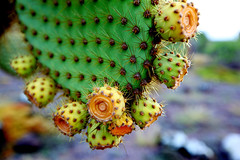 The landscape was a mixture of bare rock, low ground-hugging plants, and enormous prickly pear cactus, some large enough to virtually qualify as trees, with thick brown trunks leading up to a riot of fleshy green cactus pads above our heads, bristling with vicious looking spikes. The ground cover plants showed sprays of bright yellow flowers, which several of the iguanas were busy eating. Flitting amongst the cactus were small brown birds, later identified as common cactus finches, a common inhabitant of such terrain in the Galapagos, and a member of Darwin’s famous finches.
The landscape was a mixture of bare rock, low ground-hugging plants, and enormous prickly pear cactus, some large enough to virtually qualify as trees, with thick brown trunks leading up to a riot of fleshy green cactus pads above our heads, bristling with vicious looking spikes. The ground cover plants showed sprays of bright yellow flowers, which several of the iguanas were busy eating. Flitting amongst the cactus were small brown birds, later identified as common cactus finches, a common inhabitant of such terrain in the Galapagos, and a member of Darwin’s famous finches.
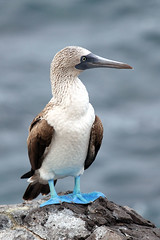 Further walking across the lava rock brought us to the cliffs on the south side of the island. Here numerous sea birds were nesting, eating, or just generally hanging out. We saw magnificent frigatebirds, swallow-tailed gulls, and blue-footed boobies. The frigatebirds are large, glossy black birds, with long, narrow, straight beaks with a hook at the end. The males have bright red throat sacs, which they inflate like balloons during courtship displays, but which here were deflated and wrinkly. They look slightly evil on land, but are graceful flyers, with swept back wings and two long, elegant tail plumes trailing behind. The gulls are attractive birds, with dark grey heads and bright red rings around their eyes. Mostly they stood around on rocks near the cliff; I don’t recall seeing any flying. Finally, the boobies are comical and fascinating seabirds, with fat necks and a face tapered down to a pointy beak which they use for catching fish. Of course, the most striking feature about them is their bright blue feet, which present such a striking colour to the eyes that you can’t help staring at them.
Further walking across the lava rock brought us to the cliffs on the south side of the island. Here numerous sea birds were nesting, eating, or just generally hanging out. We saw magnificent frigatebirds, swallow-tailed gulls, and blue-footed boobies. The frigatebirds are large, glossy black birds, with long, narrow, straight beaks with a hook at the end. The males have bright red throat sacs, which they inflate like balloons during courtship displays, but which here were deflated and wrinkly. They look slightly evil on land, but are graceful flyers, with swept back wings and two long, elegant tail plumes trailing behind. The gulls are attractive birds, with dark grey heads and bright red rings around their eyes. Mostly they stood around on rocks near the cliff; I don’t recall seeing any flying. Finally, the boobies are comical and fascinating seabirds, with fat necks and a face tapered down to a pointy beak which they use for catching fish. Of course, the most striking feature about them is their bright blue feet, which present such a striking colour to the eyes that you can’t help staring at them.
We spent several minutes admiring the various birds, as well as the many land iguanas who were also around. We walked along the cliff top to the eastern end of the island. It began raining as we did, and we donned our rain ponchos again, only to take them off again a few minutes later as the rain eased off again. It was too hot and humid to leave the plastic ponchos on any longer than absolutely necessary. Near the eastern end of the island, we found the bleached skeleton of a large sea lion. William said it was a male that had died here several weeks ago. I was amazed that sea lions dragged themselves this far up the rock slope from the sea – I doubt they could have come up the cliff – and also at how clean and dismembered the skeleton was only a few weeks after the sea lion had died.
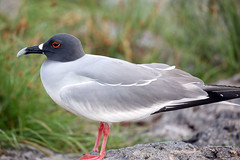 From here we walked a circuit back down the slope on the eastern side and then along the sloping shore on the northern side of the island. This gave us more chances to see cactus, lots of iguanas, and a better look at the sea lions littering the slope into the sea. The truly amazing thing about this excursion was that, unlike yesterday, all the animals here are completely wild and not captive. But despite this they showed no fear of humans whatsoever, allowing us to get within touching distance (although William reminded us to keep a metre or two away). It was really an astonishing feeling being able to observe such a large number of unique animals so easily and closely.
From here we walked a circuit back down the slope on the eastern side and then along the sloping shore on the northern side of the island. This gave us more chances to see cactus, lots of iguanas, and a better look at the sea lions littering the slope into the sea. The truly amazing thing about this excursion was that, unlike yesterday, all the animals here are completely wild and not captive. But despite this they showed no fear of humans whatsoever, allowing us to get within touching distance (although William reminded us to keep a metre or two away). It was really an astonishing feeling being able to observe such a large number of unique animals so easily and closely.
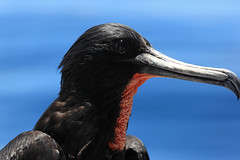 The circuit completed, we returned to the Galapagos Voyager for a midday rest while it sailed a couple of hours from South Plaza and to the new island of Santa Fe. We had lunch during this time, which included a stroganoff and chicken pieces, plus the usual salads. One of the ingredients in the salad is hearts of palm, which some of the others had trouble identifying. We had some spare time after eating to enjoy the boat cruising across the sea. We were being followed by frigatebirds, and a couple rested by landing on the boat. We could get quite a close look at them.
The circuit completed, we returned to the Galapagos Voyager for a midday rest while it sailed a couple of hours from South Plaza and to the new island of Santa Fe. We had lunch during this time, which included a stroganoff and chicken pieces, plus the usual salads. One of the ingredients in the salad is hearts of palm, which some of the others had trouble identifying. We had some spare time after eating to enjoy the boat cruising across the sea. We were being followed by frigatebirds, and a couple rested by landing on the boat. We could get quite a close look at them.
At Santa Fe Island, the first thing we did was a snorkelling session. Those of us who wanted to grabbed snorkelling gear and piled into the rubber dinghies for a short trip across to a shallow area in the bay where we could get a good look at various colourful fish. There were also a few sea lions in the water, and they playfully and curiously approached us to see what was going on. William had said that you could play with the sea lions by blowing bubbles underwater, and they would chase the bubbles. I tried it a couple of times and sea lions certainly swam around nearby, but I didn’t really see any chasing my bubbles. At one point I was swimming near a sea lion that was sitting on the rocky shore, and William called a warning to me not to get too close, because it was a male and could potentially bite me. I steered clear and gave that one a wide berth.
 Several of the fish species I’d seen I identified later using a fish guide on board the boat, but can’t recall them all now. Examples include the king angelfish, razor surgeonfish, sergeant majors. While snorkelling, members of our group ended up slightly separated, and some of us saw a pair of Pacific green turtles in the shallow water, resting on the sandy bottom near a cluster of rocks, and occasionally emerging to breathe. Unfortunately, it wasn’t possible for us to notify all the snorkellers, so some of the group missed seeing this.
Several of the fish species I’d seen I identified later using a fish guide on board the boat, but can’t recall them all now. Examples include the king angelfish, razor surgeonfish, sergeant majors. While snorkelling, members of our group ended up slightly separated, and some of us saw a pair of Pacific green turtles in the shallow water, resting on the sandy bottom near a cluster of rocks, and occasionally emerging to breathe. Unfortunately, it wasn’t possible for us to notify all the snorkellers, so some of the group missed seeing this.
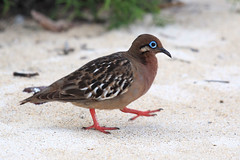 Snorkelling done, we had time to shower quickly before another land excursion. The dinghies took us to a small beach on Santa Fe. On the way, William spotted the turtles again, and took the dinghies over to have a close look, so that those who didn’t see them earlier could get a look. On the beach, there were dozens of sea lions, females and young, lolling around. A few were active, tripping in and out of the water or across the sand, but most were simply lying around in the sun. Around the beach area we also saw more lava lizards and, for the first time, Galapagos doves. These birds are attractive ground doves, with a bright blue ring of flesh around the eyes. They strutted about on the sand at the edges of the beach, near plant cover, which they retreated to if approached too closely.
Snorkelling done, we had time to shower quickly before another land excursion. The dinghies took us to a small beach on Santa Fe. On the way, William spotted the turtles again, and took the dinghies over to have a close look, so that those who didn’t see them earlier could get a look. On the beach, there were dozens of sea lions, females and young, lolling around. A few were active, tripping in and out of the water or across the sand, but most were simply lying around in the sun. Around the beach area we also saw more lava lizards and, for the first time, Galapagos doves. These birds are attractive ground doves, with a bright blue ring of flesh around the eyes. They strutted about on the sand at the edges of the beach, near plant cover, which they retreated to if approached too closely.
After a few minutes spent wondering if we were just going to stand around near the beach or do anything else, William led us inland on a path that climbed up a short slope through scrubby bush. This let us see more lava lizards, plus the different Barrington land iguana, a different species of land iguana endemic to Santa Fe, as well as colourful painted locusts and some large web-spinning spiders. There were lots of very tall prickly pear cactus plants dotting the landscape, as well as ground plants with bright yellow flowers. Near the top of the ridge and overlooking the sea below were blue-footed booby nests, and the rocks were again crawling with the bright red Sally Lightfoot crabs.
 We returned to the beach as the sun was going down and took the dinghies back to the boat. Waiting for us in the lounge were freshly baked yuca biscuits, still warm from the oven. I discovered ony after getting home and researching that yuca is a local name for cassava, and we hadn’t eaten things made from the cactus-like yucca plants that I had thought. The biscuits had a crispy outer layer and were warm and chewy in the middle. A bowl of honey was there for us to dip them into. They were delicious and M. and I ate several each. Then we had time to rest and freshen up before dinner. During this time, the sun set spectacularly over Santa Fe Island, colouring a patchwork of cloud above and the shimmering water below with a glorious palette of warm hues. Brian and I stood on the sun deck of the boat, trying to capture this spectacle with our cameras.
We returned to the beach as the sun was going down and took the dinghies back to the boat. Waiting for us in the lounge were freshly baked yuca biscuits, still warm from the oven. I discovered ony after getting home and researching that yuca is a local name for cassava, and we hadn’t eaten things made from the cactus-like yucca plants that I had thought. The biscuits had a crispy outer layer and were warm and chewy in the middle. A bowl of honey was there for us to dip them into. They were delicious and M. and I ate several each. Then we had time to rest and freshen up before dinner. During this time, the sun set spectacularly over Santa Fe Island, colouring a patchwork of cloud above and the shimmering water below with a glorious palette of warm hues. Brian and I stood on the sun deck of the boat, trying to capture this spectacle with our cameras.
Tonight dinner included a delicious beef lasagne, plus some tuna mornay type dish, as well as the usual selection of vegetables and salads. Again, post-dinner socialising was minimal, as everyone was so worn out from the day’s activities. Few people were getting decent sleep either, given the rocking of the boat and the engine noise during the night, so we were all pretty tired and keen to get an early night.
